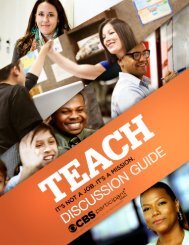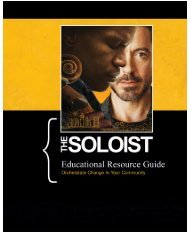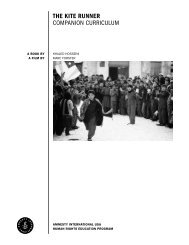Sharpen your conflict resolution skills with our activity guide - TakePart
Sharpen your conflict resolution skills with our activity guide - TakePart
Sharpen your conflict resolution skills with our activity guide - TakePart
- No tags were found...
Create successful ePaper yourself
Turn your PDF publications into a flip-book with our unique Google optimized e-Paper software.
Procedures:1. Write the following terms on the chalkboard or on chart paper:• Peer pressure • Greed• Bias• Miscommunication• Oppression • Fear• Ethnocentricity • Need2. Ask for volunteers to read each of the terms aloud. Brainstorm definitions and examples foreach term, recording student responses as “word webs” on the chalkboard or on chart paper.These word webs should remain visible for reference throughout the following <strong>activity</strong>.3. Ask the class what all these terms have in common. Explain that these concepts are often thecause of <strong>conflict</strong>—both on a personal level, such as a <strong>conflict</strong> between friends, as well as on alarger level, such as a civil war or even genocide.4. Ask the class for examples of a <strong>conflict</strong>, and have them relate that <strong>conflict</strong> to one of the termson the board. Elicit examples of <strong>conflict</strong> that exist personally (between friends, familymembers), locally (gang rivalries, school rivalries, local ethnic <strong>conflict</strong>s), and globally (theVietnam War, Khmer Rouge, Darfur, war in Iraq, etc.).5. Explain that during the next <strong>activity</strong>, they will be discussing personal opinions and feelingsthat relate to these topics, and that it is important to respect each other’s responses andperspectives.Note: It may be helpful to establish ground rules for discussion before this <strong>activity</strong>, to ensureproductive and respectful dialogue. See Activity: Setting Ground Rules for Conversations inClass.6. Divide the class into pairs. Give each student a copy of Student Handout: InterviewingPeers.7. Allow 10 minutes for one student to interview his or her partner using the questions on Page1 of the handout. Students should take notes on their partners’ responses in the spaceprovided.8. After 10 minutes, instruct students to “switch.” The interviewer will become the interviewee,and vice versa. Allow 10 minutes for students to complete Page 2 of the handout.9. After every student has had the opportunity to be both interviewer and interviewee,reconvene as a whole group to discuss the <strong>activity</strong>. Enc<strong>our</strong>age students to share <strong>with</strong> theclass some of the answers they gave in pairs. Use some or all of the following questions to<strong>guide</strong> the discussion:• How have <strong>y<strong>our</strong></strong> personal experiences <strong>with</strong> censorship affected you? When have you feltcensored?• How do you feel when <strong>y<strong>our</strong></strong> freedom of expression is limited? Why is <strong>y<strong>our</strong></strong> freedom ofspeech important to you?• How has the spirit of cooperation or collaboration affected <strong>y<strong>our</strong></strong> neighborhood or school?• When have you seen a lack of cooperation result in hostile behavior?www.takepart.com/JimmyCarterManFromPlains









